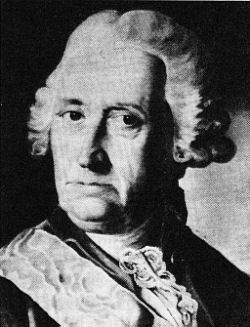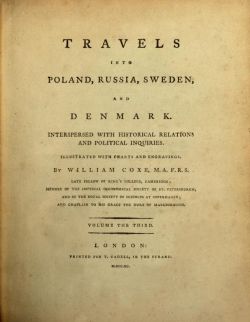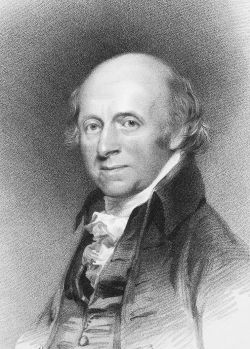William Coxe
The author, William Coxe, was an English historian and priest who served as a traveling companion and tutor to nobility from 1771 to 1786. He wrote numerous historical works and travel chronicles. Ordained a deacon in 1771, he served as a rector and then archdeacon of Bemerton near Salisbury from 1786 until his death.
He was born in London, educated at Marylebone Grammar School (1753–54) and then at Eton College (1754–64), Coxe matriculated to King's College, Cambridge in 1765, receiving his baccalaureate in 1769 and his masters' degree in 1772. From 1768 to 1771, he was a fellow of King's College. Coxe was ordained a deacon in London in 1771 and a priest in 1772.
Coxe traveled throughout Europe as a tutor and traveling companion to various noblemen and gentlemen, including Lord Herbert, son of the Earl of Pembroke; and Samuel Whitbread of the brewing family. He wrote voluminous and detailed accounts of his travels with Lord Herbert around the Swiss and French Alps
In 1786 he was appointed vicar of Kingston upon Thames, and in 1788 rector of Fugglestone St Peter-with-Bemerton, Wiltshire. He also held the rectory of Stourton, Wiltshire from 1801 to 1811 and that of Fovant from 1811 until his death. In 1791 he was made prebendary of Salisbury, and in 1804 Archdeacon of Wilts, also until his death.
In 1803, Coxe married Eleanora, daughter of William Shairp, consul-general for Russia, and widow of Thomas Yeldham of St Petersburg.
Excerpted from Wikipedia.
 Portrait of George Browne
Portrait of George BrowneGeneral Browne
The more we look into Latvia's past, one litmus test that Latvians weren't masters in their own home was the actual masters of Rīga. In the 20th century, there was fourth mayor of Rīga, George Armitstead — born into a British merchant family living in Rīga; his uncle was George Armitstead, 1st Baron Armitstead. Jaunmokas Manor, a popular tourist attraction today, was built in 1901 as his hunting lodge.
And so were were curious about General Browne, governor of Rīga, whom Coxe mentions in some detail.
George Browne, soldier of fortune, Russian army officer, governor of Livonia, and count of the Holy Roman Empire, was born June 15 1698 at Moyne (Castle Mahan), Co. Limerick, son of George Browne of Camas (an uncle of the Austrian marshal Maximilian Ulysses von Browne) and his wife Honora de Lacy. Educated in the diocesan school in Limerick, he left Ireland with his impoverished father in 1723 to enter the Palatine service. Later in the 1720s he went into the Russian service with James Keith, younger brother of the Earl Marischal of Scotland. He distinguished himself in the Polish, French, and Turkish wars, serving under Peter Lacy (qv), "the Prince Eugene of Muscovy," and Lacy's rival Count Munnich. He attained the rank of major-general with command of an army of 30,000 men and served under the Austrian generals Crawford and Wallis against the Turks.
Taken prisoner by the Turks, possibly at Crocyka (1739), he avoided paying a huge ransom by persuading his captors that he was a lowly captain; he served as a galley slave until he was sold to an Albanian merchant. An unnamed Irishman in the Turkish service brought Browne's plight to the attention of the French ambassador, who ransomed him for fifty ducats. While a prisoner of the Turks he apparently discovered important state secrets. Armed with this knowledge he allegedly walked from Turkey to St Petersburg, where the tsarina Anne rewarded him with promotion to general. He then served with General Peter Lacy during his expedition to Finland in the 1740s. During the Seven Years' War (1756–63) Browne served as a lieutenant-general in the Austrian army, which was operating as an ally of Russia in Serbia and Hungary, taking part in the battles of Lobositz (1756), Prague (1757), and Kolin (1757) under the command of his cousin Maximilian Ulysses von Browne (1705–57). He was wounded by Prussian officers at Zorndorf in 1758, receiving three pistol shots and losing part of his skull; he recovered, despite having to have his skull repaired with a piece of silver plate, and received the order of St Andrew from Tsar Peter III.
For this service he was named field-marshal and given command of the Russian forces sent to invade the Danish province of Schleswig in 1762. Declaring the war to be impolitic, he was temporarily deprived of his honours, discharged from the Russian service, and ordered to leave the country. Peter reversed his decision three days later and appointed him governor of Livonia; he was confirmed in this office by Catherine II. In his thirty years of service as governor he reorganized the legal system, social institutions, and schools in the Baltic provinces, built new roads, towns, and schools, and deepened the harbor. Refused permission to retire by Catherine, who promised him that "death alone would rob me of your services," he took a coffin wherever he went in protest and used it as a stand to wash crockery. He died in Livonia 18 February 1792 at the age of 93.
He married first Eileen (further details unknown); they had one son, who died without issue, and two daughters, one of whom was the ancestor of Fr William Clare, founder of the Irish Genealogical Research Society and author of an account of Browne's colorful career, written in the 1930s. He later married a Baltic noblewoman and had one son and possibly a daughter. An engraving is reproduced in the Clongownian, iv (1905), 46.
From the Dictionary of Irish Biography.
Notes
Our transcription is of Volume III, Chapter IV, dated "M.DCC.XC," 1790. Our research indicates the first edition of this work was published in 1784. This volume is an addendum to that first edition. (The third edition was published in 1787.)
ADVERTISEMENT TO THE THIRD VOLUME
IN this additional Volume, the Author submits to the Public a continuation of those observations, which a second journey into the northern kingdoms of Europe has enabled him to make ; and more particularly an account of those countries which he did not visit in his former tour ; namely, Jutland, Norway, Livonia, Courland, and Prussia.
BEMERTON,
NOVEMBER 2, 1790.
 Gallery
Gallery

